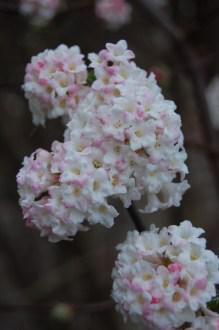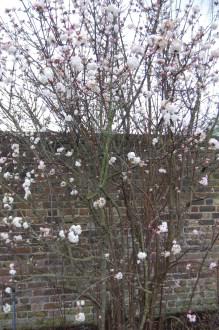
Viburnum x bodnantense ‘Charles Lamont’ flower (21/01/2012, Kew, London)
Position: Full sun, will tolerate partial shade
Flowering period: Winter to early spring
Soil: Moist, well drained
Eventual Height: 3m
Eventual Spread: 2m
Hardiness: 6a – 9b
Family: Caprifoliaceae
Viburnum x bodnantense ‘Charles Lamont’ is a fast growing, upright, bushy deciduous shrub . Its leaves are dark green, oval in shape with simple, palmate lobes. The branches of this shrub are upright when young, as the plant matures the branches arch. The scented flowers of the plant are produced in small clusters, initially pink buds, opening to fragrant white flowers, they are virtually sterile producing only a few small black or purple fruits which are small and spherical in shape.
Viburnum x bodnantense ‘Charles Lamont’ is commonly known as Bodnant Viburnum, Winter Flowering Viburnum or Arrowhead Charles Lamont. The species Viburnum x bodnantense was produced in 1934 by crossing V. grandiflorum with the fragrant species V. farreri in Bodnant Gardens.

Viburnum x bodnantense ‘Charles Lamont’ (21/01/2012, Kew, London)
The etymological root of the binomial name Viburnum is from the Latin name for Viburnum lantana, or the Wayfaring Tree. Bodnantense is named after Bodnant Gardens, where this plant was created. Charles Lamont is named after the assistant curator at the Royal Botanical Gardens in Edinburgh in 1933 who was responsible for the first successful attempt at creating this interspecific cross.
The landscape architect may find Viburnum x bodnantense ‘Charles Lamont’ useful as a fragrant winter flowering shrub.
Ecologically, V. x bodnantense ‘Charles Lamont’ are sometimes eaten by the larvae of some Lepidoptera species. Its flowers are a valuable source of nectar for insects during the winter months.
The Royal Horticultural Society has given V. x bodnantense ‘Charles Lamont’ their prestigious Award of Garden Merit in 1993.
V. x bodnantense ‘Charles Lamont’ prefers moist, fertile, humus rich, well-drained soils. It tolerates most pH of soil.
V. x bodnantense ‘Charles Lamont’ requires little maintenance. To encourage healthy growth, older shoots can be removed to ground level after flowering to give space to the younger more vigorous shoots.
Advertisement
